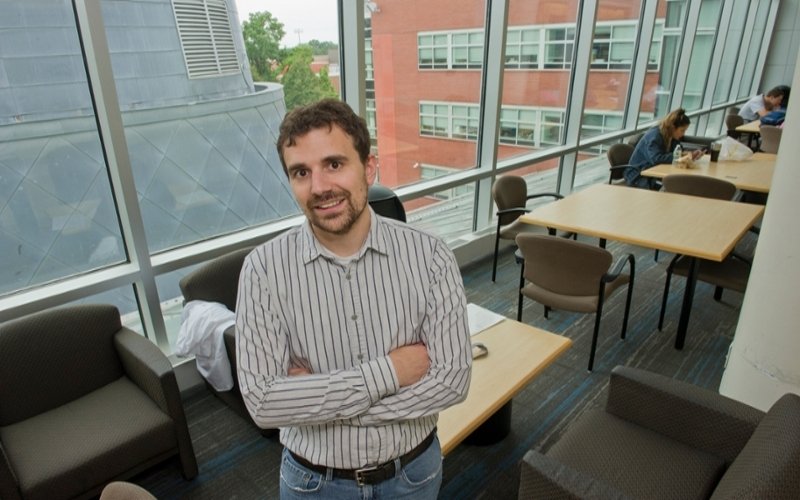Rowan’s Grinias receives NSF grant to explore greener research methods
Rowan’s Grinias receives NSF grant to explore greener research methods

In laboratories around the world, researchers use a technique called chromatography to separate out molecules from chemical mixtures. It’s the most common way they can isolate these molecules to study them – a necessary step in almost all work in chemical analysis.
There’s just one problem: the most common methods of chromatography create considerable chemical waste. This waste is something that researchers, many of them working in the field of environmental testing, want to avoid.
Dr. James Grinias, assistant professor in the Department of Chemistry & Biochemistry in Rowan University’s College of Science & Mathematics, may just be pioneering the next step in developing greener methods. The National Science Foundation (NSF) awarded him a three-year, $228,399 grant to work on a project to advance a promising alternative chromatography technique.
What’s so super about supercritical fluid chromatography?
Supercritical fluid chromatography (SFC) is different from other methods of molecule separation used in chemical analysis because it uses less of the potentially harmful solvents needed to separate chemical molecules.
“Supercritical fluid chromatography is an interesting approach because it is a ‘greener’ strategy,” said Grinias. “It generates less chemical waste than other common chromatography techniques.”
In this project, Grinias will use supercritical fluid chromatography in the separation of certain types of polar molecules: the ones that play a part in metabolism inside the human body. He intends to develop the precise specifications needed to separate these molecules using this method.
A collaboration with partners 800 miles away
Grinias, the principal investigator at Rowan, is also working with researchers at Saint Louis University, who have received a separate but related award for their portion of the research. Grinias will work with his team, which he anticipates will include at least two graduate and two undergraduate students, to prepare samples and separate molecules using a newly developed two-dimensional ion exchange-supercritical fluid chromatography separation system. Throughout the project, the team will adjust and modify the instrument as needed.
“Very few universities have access to this type of instrument, making Rowan a unique place to learn this technique,” said Grinias. “The students involved in the project will gain firsthand experience using supercritical fluid chromatography, which is becoming increasingly important in the pharmaceutical industry and could eventually be used in many biomedical and environmental testing labs.”
As part of the collaboration, Grinias and his team will transfer the methods they develop to Saint Louis University, where they will be coupled with a mass spectrometer to further advance the technique.
Students’ extensive roles in the research efforts
“The student aspect of this project is truly something special,” said Alexander Kaplitz, 24, third-year pharmaceutical sciences graduate student from Egg Harbor Township whose interest in analytical chemistry inspired his involvement in the project. “The single aspect of researching supercritical fluid chromatography that I enjoy the most is the freedom.”
“When I first started this research fellowship, I wrongly assumed that the principal investigator would give me instructions every day and I would blindly follow them. Instead, I come up with my daily procedure.”
When questions arose in this experimental work that even Grinias did not have an answer to, Kaplitz said, “It was my duty to figure out the solution. I go to Dr. Grinias when I can’t figure out how to progress, and then it is a collaboration with him to identify the next step.”
“I did not expect to be this independent,” agreed Samantha Calvez, a 20-year-old junior biochemistry major with Thomas N. Bantivoglio Honors Concentration in the Honors College from Egg Harbor Township. “I work on the instrument by myself. I make decisions about which direction the project goes next. I am trusted with more responsibilities than I ever could have guessed.”
For Kaplitz, Calvez and the other students Grinias works with, this experience working independently in the lab will help them in future graduate studies and in careers inside or outside of academia.
“I specifically enjoy SFC due to it being faster and greener compared to traditional methods,” said Kaplitz. “Greener chemistry is needed to help protect our environment. The Grinias Lab is one of the leaders in the field.”
“This project has the potential to improve many common approaches to chemical separations,” said Grinias – and the efforts of his students are crucial to reaching that potential. “The work has been heavily driven by the students thus far. I am very lucky to work with such a talented and motivated team.”